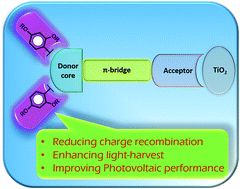Molecular engineering of organic sensitizers with o,p-dialkoxyphenyl-based bulky donors for highly efficient dye-sensitized solar cells
Abstract
Charge recombination has always been the main factor restricting the performance improvement of dye-sensitized solar cells (DSSCs). From the view of the dye structure, the introduction of substituents like alkoxy/alkyl chains with a large steric hindrance is one of the commonly used strategies to enhance the blocking effect of dye molecules at the interface between TiO2 and the electrolyte/hole conductor. As a result, the charge recombination can be effectively hampered to improve the solar cells' performance. Here, we review the recent progress and molecular designs in the field of organic sensitizers with o,p-dialkoxyphenyl (DAP)-based bulky donor groups. The advantages and disadvantages of the bulky donor groups for the absorption spectrum, charge recombination and dye regeneration are discussed. At the end, feasible design strategies of organic sensitizers for achieving high open-circuit voltage (Voc), short circuit photocurrent density (Jsc) and stability in both liquid-electrolyte DSSCs and all-solid-state DSSCs are proposed.



 Please wait while we load your content...
Please wait while we load your content...